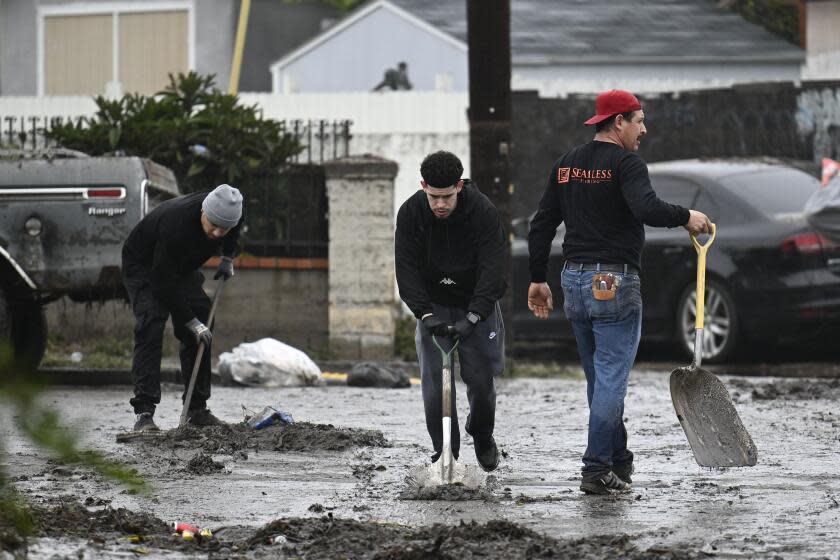California isn't prepared for turbocharged storms like the ones we're getting this week

As a series of major winter storms sweep over the West Coast this week, anxious Californians are looking back at the flash floods and the “thousand-year” deluge that shocked San Diego a week ago, and Oxnard a few weeks earlier, wondering what’s in store.
Starting Tuesday night, and then again on Sunday, two “atmospheric river” systems will bring high winds and heavy rain to Northern California, along with at least two feet of snow in the Sierra, followed by moderate to heavy rains in Central and Southern California, with a real risk of local flooding. And there are still at least two months of our wet season to go.
Read more: California braces for inundation as atmospheric rivers barrel in from Pacific Ocean
We should welcome the wet weather because California depends for most of its annual water supply on winter storms that roll in across the Pacific or sweep down from Alaska. Nevertheless, as cars bobbing down inundated city streets in San Diego vividly demonstrated, the state is not adequately prepared to deal with extreme weather events, especially the turbocharged storms that human-caused climate change can deliver.
Last year’s severe winter — nine atmospheric rivers in just a few weeks in December and January — was both a reminder of the threat of a megastorm, the so-called ARkStorm, like the one that flooded the entire Central Valley in the winter of 1861-62 killing thousands, and a preview of the vulnerabilities California faces in dealing with extreme climatic events.
We were lucky last year in two respects. Although the storms’ massive precipitation — the state's rainfall total was 141% of the annual average — built up a deep snowpack in the mountains, abnormally cool temperatures allowed it to melt slowly over the spring and summer. Rapid snowmelt, with its risk of flooding, is a nightmare scenario for disaster planners.
Read more: Opinion: Catastrophic floods and breached levees reveal a problem California too often neglects
The other saving grace was that California’s reservoirs were relatively empty after three years of drought, providing floodwater storage space for the winter rains and snowmelt.
Even with those advantages, the southern San Joaquin Valley saw spring river flows that overwhelmed some reservoirs and river capacity and led to the re-flooding of ancient Tulare Lake, which had been dry for decades because of agriculture’s water diversions.
This winter, our major reservoirs are at, or above, normal, so a long series of especially wet storms could still require emergency releases from major dams and some nail-biting on the part of water managers.
What do we need to do to be better prepared? We have to manage water for tomorrow’s climate, not yesterday’s.
Read more: Opinion: We've seen the flooding in California. Will we move to higher ground?
We have channelized and leveed California’s rivers and then built homes and businesses in the floodplains, exposing them to costly damage. Now we need to move the levees back, expand floodplains, slow our rivers down and do a better job of capturing precipitation that falls as rain, not snow, in a warmer climate.
We have massively over-pumped and degraded aquifers throughout the state while simultaneously reducing the ability of nature to recharge them. Groups such as Sustainable Conservation are partnering with farmers, environmental organizations and the agricultural industry to pilot projects that will allow land along rivers to be inundated during winter, which will slow floodwaters and enhance groundwater recharge in the Central Valley. There are even recharge sites along the mostly channelized Los Angeles River and in other urban areas around the state. These programs need to be dramatically scaled up.
Insurance policies, including those of the National Flood Insurance Program, need to be revamped to protect vulnerable communities while at the same time discouraging building — and rebuilding — in floodplains.
Read more: Dramatic before-and-after images show how much water California reservoirs have accumulated
And the state must update its building codes and construction standards to make housing and whole communities more resilient.
California’s Department of Water Resources has developed language to modify local regulations in coordination with model ordinances prepared by the Federal Emergency Management Agency in 2020. The new rules would require strengthening and raising buildings, expanding flood setbacks, reducing the risk of repetitive losses and requiring developers in high-risk areas to set aside open areas and parks that can be flooded without threatening lives or property.
Building resilience against extreme weather will take time but that just means we need to work fast. And yes, it will be costly, but spending now to prepare for very wet and very dry seasons will cost far less than having to pay for future disasters. In May, Gov. Newsom proposed nearly half a billion dollars for one-time flood relief, but consistent, long-term funding is needed.
Atmospheric rivers and bone-dry droughts are like earthquakes and wildfires — challenges Californians have to face. We know they’re coming; we just don’t know exactly when or where. An earthquake-resilient house or a more flood-resilient community won’t stop the ground from shaking or the rain from falling, but it can mean the difference between weathering the storm or cleaning up after a disaster.
Peter Gleick is a hydroclimatologist, a senior fellow at the Pacific Institute in Oakland, and the author of "The Three Ages of Water."
This story originally appeared in Los Angeles Times.
